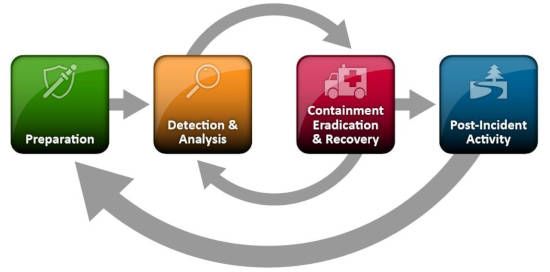COVID-19; Lessons from Security Incident Response
For the past few decades, threats of an 'epidemic' or 'pandemic' nature have loomed over digital assets and infrastructures. Do you remember the DDoS attack in 2002 that targeted a dozen of DNS root servers in the US and almost brought the Internet to its knees? What about the ILOVEYOU virus, which affected more than 10% of the world’s computers and caused an estimated $10 billion worth of damages? Essentially, any zero-day attack targetingthe core internet infrastructure and popular applications is potentially disastrous. The risk is even higher given the impressive volume and frequency of threats (an attack occurs every 39 seconds, on average 2,244 times a day, according to University of Maryland). As a result, security professionals have enhanced their security incident response (SIR) mechanisms. With slight variations, SIRs follow the guidanceof NIST SP 800-61 and generallyconsist of four phases: preparation; detection and analysis; containment, eradication and recovery; and post-incident activity. As the world responds to COVID-19, what can we learn from SIR? Early detection In SIR, as with COVID-19, precursors on a subject (clues that an incident may occur in the future) are difficult to identify. It is difficultto detect a potential COVID-19 patient untilhe starts exhibitingthe symptoms. The good news is that COVID-19 is easily detectable. Indicators such as symptoms and abnormal behaviorson human subjects are well known. However, spotting an incident early is essential to mitigate it effects. In AppSec, traffic is continuously monitored and inspected 24/7 in real time, using rules-based and anomaly-based detection to detect traffic posing a threat. Artificial intelligence (AI) and machine learning (ML) augment detection by improving accuracyrates while reducing false positives. Similarly, deploying significant efforts in early detection of COVID-19 patients. A higher capacity to monitor the population for COVID-19 symptoms (analogy of rules-based detection) can lead to early detection. Early Containment Once a threat is identified, it needs to be contained. Containmentis a mitigation strategy enacted while a permanent fix is being develop. The main goal of containment is to reduce the speed of contamination by isolating affected subjects. My coworker, Raymond Pompon, has illustrated containment strategies similarities between SIR and the COVID-19 response inContainment is Never Perfect. Despite the residual risk, as with early detection, early containment is essential at reducing the attack surface. Moreover, containment provides an environment for information gathering in point- and contextual-threat analysis. In that regards, SIR strategies includes sandboxes and honeypots systems to aid further threat analysis. Tightening Security Posture As a threat is identified and containment strategies are implemented, when facing a looming threat, it is common practice in SIR to perform risk assessment and review and enhance the security posture of non-infected systems. Even when a permanent fix is not yet available, a looming threat imposes the need for a review of the security architecture and processes to identify and mitigate possible inflections points, threat actors, and attack vectors. With COVID-19, similar process is being observed and should be encouraged because organizations and households are reviewing theirprotocols, hygiene, and safety policies. Communication Plan In SIR as with the COVID-19, managing communication is a big challenge. To quote World Health Organization Director-General Tedros Adhanom Ghebreyesus, "Our greatest enemy right now is not the virus itself; it's fear, rumors,and stigma." Large organizations concerned for theirreputation have developedspecific security incident communication plan that reflects the nature, scope, risk, and impact of an attack. Communications are typically delivered by security leadership in the organization to stakeholdersfollowing the guidance of transparency. Special considerationare taken when a communication could be use for reverse engineering and be detrimental to the organization. However, an interesting model is the way Vulnerability Disclosure operates in computer security. An independentresearcher or ethical hacker not affiliated with an organization could discover a threat or vulnerability and report it directly to the affected organization or through a bounty program. Using such communication channel, an organization can take mitigation action. In SIR, as with COVID-19, a collaborative communication approach could hep in early detection, early containment, and tightening of the security posture.844Views2likes0Comments
